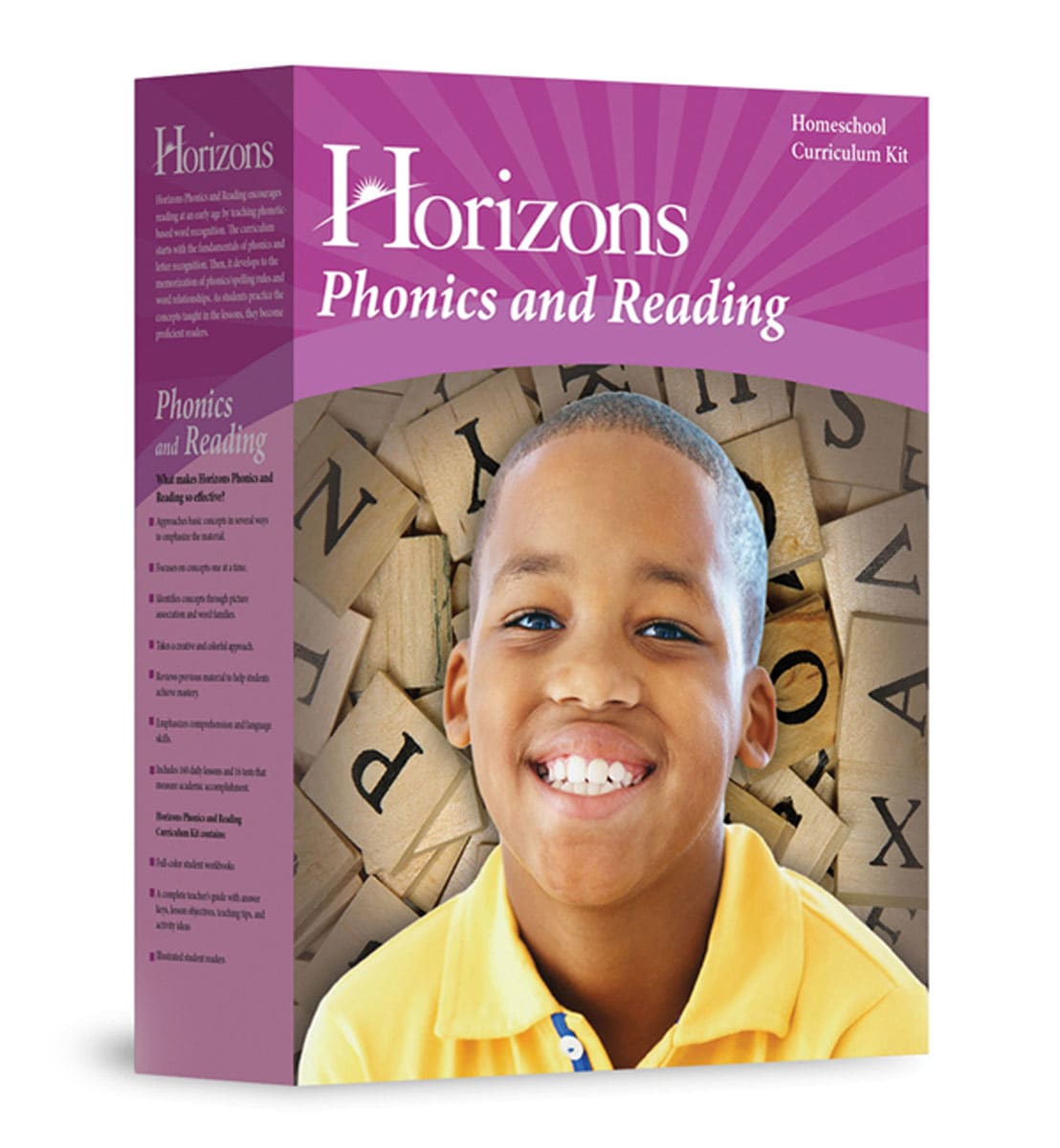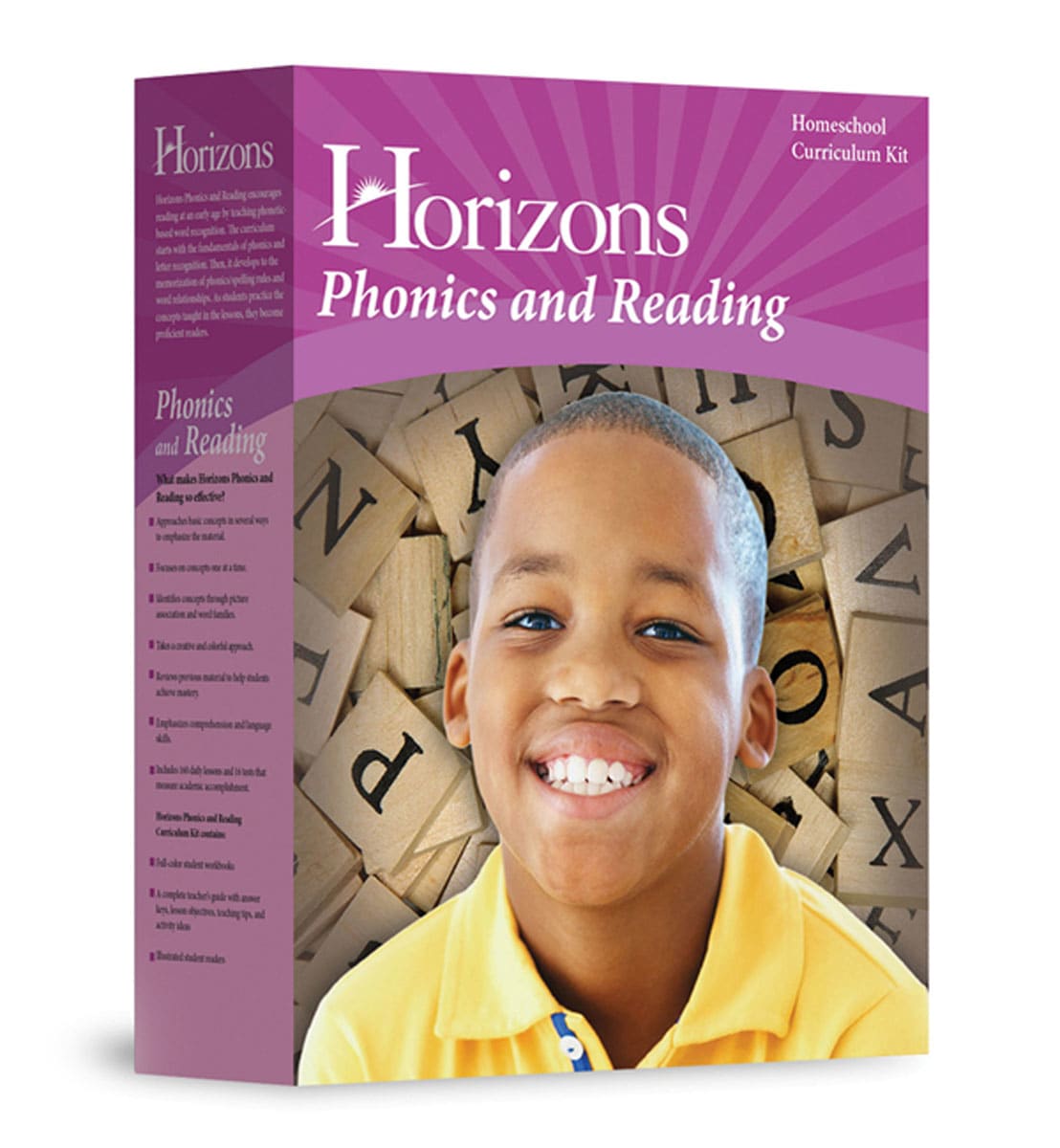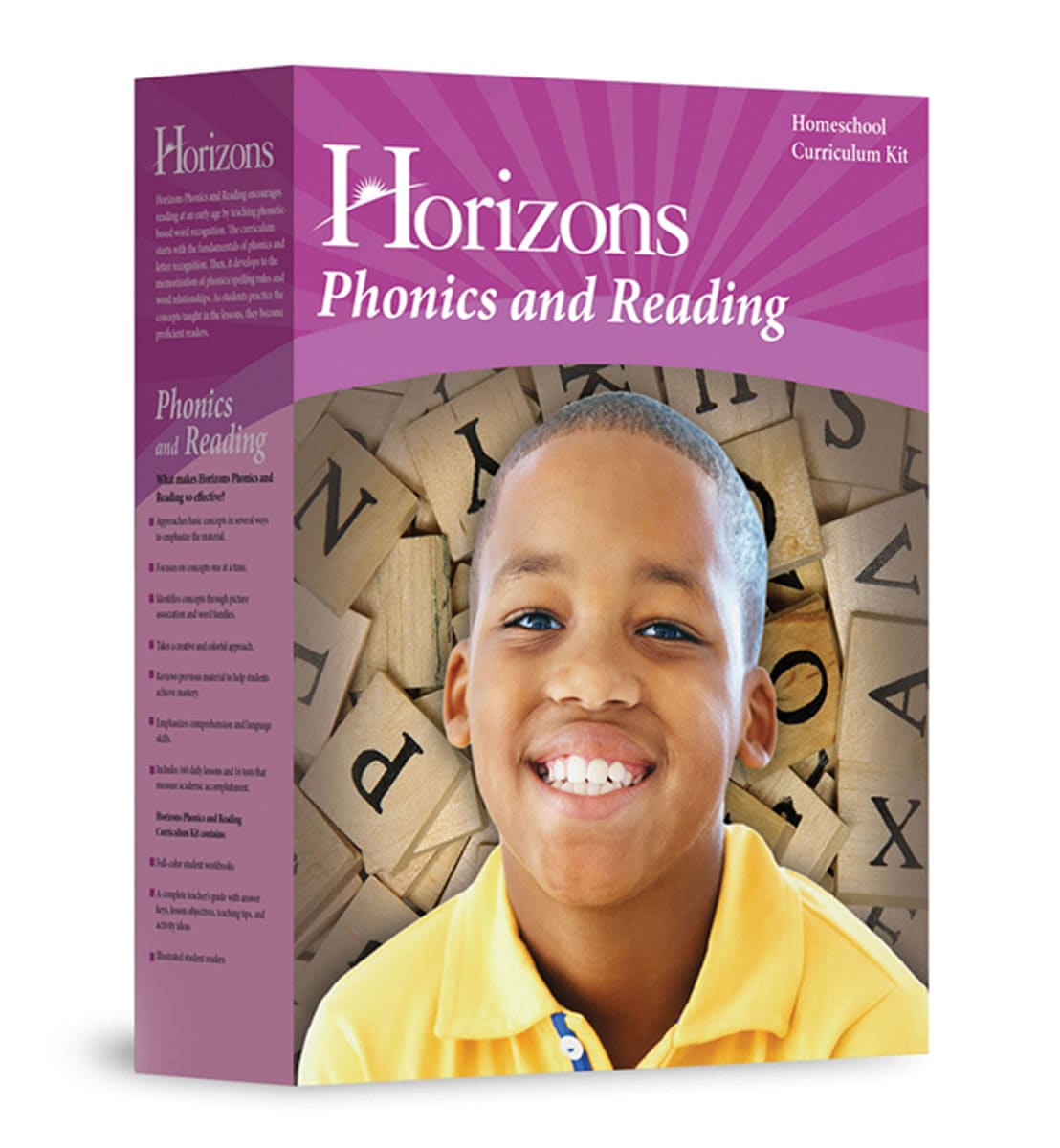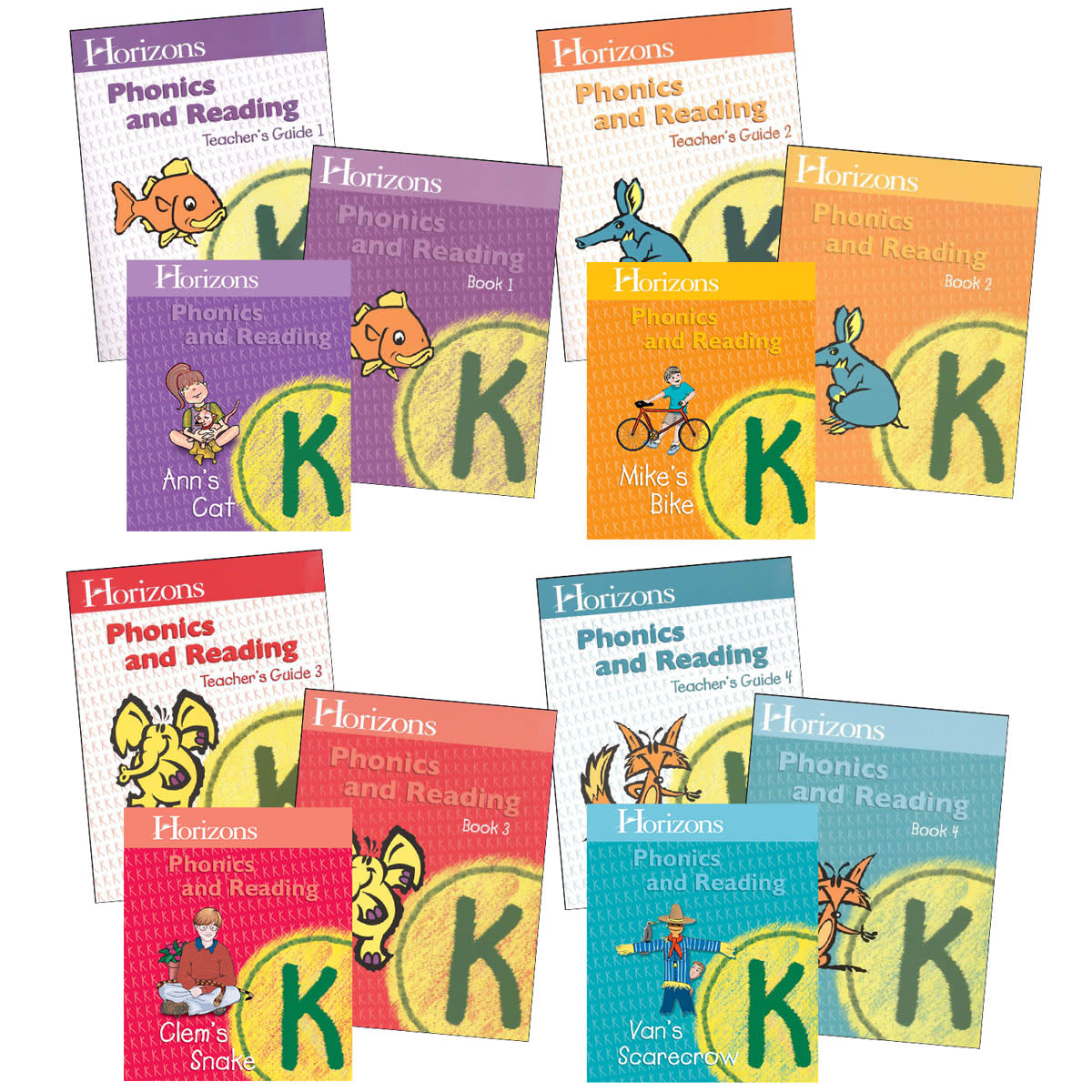The Horizons Phonics and Reading program is very attractively presented in full-color books throughout, but it is advanced in comparison to most other programs. It is a strongly academic program with lots of worksheets to be completed. As far as methodology, this is a phonics-based program that uses a consonant-vowel approach (e.g., ba, bi, bo) to teach blending.
The program has four levels covering kindergarten through third grade. However, before beginning level K, children should already have some familiarity with the alphabet, adequate small motor coordination for the writing required, and a general level of readiness exhibited by such skills as being able to focus and retain information. Not all kindergarteners will be ready for such a challenging program.
Lessons are written for classroom situations, but they should adapt easily for homeshool use. Each level has 160 lessons. Level K begins by introducing the letter “a” in the first lesson. That “introduction” includes learning the name of the letter, the short vowel sound, how to write both upper and lower case “a,” two vowels rules, and recognition of the sound in words. Discussion of the vowel rules strangely seems to be missing any sort of definition of vowels or identification of the other vowels.
The second lesson teaches the letter “b” as above except for the vowel rules. One of the activities in this lesson is to blend the sounds of “b” and “a”. All five vowels are introduced by lesson 11, and students are already decoding three-letter nonsense syllables (feb, fab, fef, fof) in the seventh lesson. Lessons continue in this fashion using a mixture of real words and nonsense syllables to emphasize the phonetic approach. Long vowels begin to appear in lesson 41.
In level K, there are from three to six student worksheets for every lesson. Worksheets are perforated and should be removed from the workbooks to make it easier to write on them. Some of the worksheets require what I consider a significant amount of writing for a kindergarten student. You should not have students attempt to complete all of these in one sitting! By the end of level K, children are reading and writing sentences, even though most sentence writing is copying.
Horizons tries to balance this heavy-duty phonics approach by including storybooks so there is a story to accompany every lesson. Stories are to be read after the completion of each lesson. These are primarily for reading to children rather than for children to read themselves, although the teacher handbook suggests allowing students to sound out words they have covered in lessons. It also suggests having students read stories from earlier lessons as they gain reading proficiency.
The level K set includes four teacher handbooks, four student activity books, and four readers, all of which are substantial. Student workbook pages are reprinted in the teacher handbooks with answers included. The readers are around 100 pages each and there are a total of 783 student activity pages. The set also includes a small wipe-off board and pen plus what Horizons calls a “floor puzzle.” This is essentially a large alphabet poster with pictures for each letter. Horizons suggests laminating it then cutting the letters apart along the irregular lines to create individual letter cards which might also be reassembled as a puzzle.
The grade 1 program has one large, 422-page teacher handbook, two student workbooks with about 200 pages per book, and two readers. As with the level K program, there is a story in the readers for each of the 160 lessons. Grade 1 readers feature original stories on a wide array of topics. As with level K, the first 40 stories in the readers are meant to first be read to the children after each lesson rather than to be used for student practice. Students can later come back and read the stories on their own as their skills develop. After lesson 40, students should be able to start independent reading. Comprehension questions at the end of each story should be used for discussion.
While the level K teacher handbooks are essential, grade 1 student books include enough instruction that you will probably not need to use the teacher handbook hardly at all. However, the back of the teacher handbook has pages for creating alphabet cards and phonics rule cards in a teacher resources section.
Grade 1 quickly reviews concepts taught in level K, using a “ladder” format in the early lessons to review words in families such as ax, fax, lax, Max, sax, tax, and wax. Lessons move so quickly that lesson 12 is already introducing compound words. While grade 1 is quite comprehensive, it does save some more-challenging phonemes such as the various sounds of “ough” for second grade.
Phonics and Reading 1 might serve as the primary grammar/language program for first grade. It does cover such topics as alphabetizing, punctuation, capitalization, sentences, contractions, antonyms, synonyms, and homonyms, but it does not teach children to identify parts of speech.
There are from two to four workbook pages per lesson. Workbooks have a test after every ten lessons for evaluation. Students do quite a lot of writing in this program, and writing is sometimes at an advanced level for most first graders. For example, lesson 89 requires them to write a “personal experience narrative.” Instructions say: “Have your teacher or writing partner help you write your narrative. Remember to tell what you did, where and when you did it, and why it was fun.” This sort of assignment might not be as overwhelming as it sounds if the parent works closely with the child.
While parents need to work closely with children at this level, children should become more independent as they reach the point where they can read their own workbook instructions.
Grades 2 and 3 review the basic phonograms each year, but more quickly and briefly. Each level continues to build and expand upon that foundation. Both levels have a teacher’s guide, two readers, and two student workbooks.
Even if children can read the stories in the readers on their own, they should be reading aloud so that parents can assess their fluency and assist as needed. Comprehension questions for each story are found in the teacher’s guides. No answers are provided for those questions until grade 3, so parents also need to hear the stories to judge the accuracy of student responses. Workbooks include two pages of activities for each lesson. Tests follow every tenth lesson.
Although Alpha Omega is a Christian publisher, there is hardly any explicitly Christian content in the first three levels although there is a strong emphasis on character building. Third-grade readers include a number of religious stories such as stories about John Newton and Mother Teresa, and the scriptural story of the Good Samaritan.
Second-grade readers have taken two classic stories, Robinson Crusoe (rewritten for children by James Baldwin) and A Little Princess, and broken them down into sections appropriate for daily reading. A small sampling of classic poetry and a few prose selections from sources, such as The American Spelling Book by Noah Webster, introduce each of the two second-grade readers. Third-grade readers host a collection of classic tales and poetry along with non-fiction and biographical pieces. Reading material in grades 2 and 3 does not tie as closely to lessons as in earlier levels which makes sense since children should be familiar with almost all phonograms by this point.
Horizons Phonics and Reading is designed to be taught rather than used for independent study. While students might be able to complete workbook pages on their own, some lesson instruction is presented from the teacher’s guides, even at the third-grade level. You will need a whiteboard or chalkboard for most lesson presentations. Lessons require minimal advance preparation.
Horizons Phonics and Reading is more demanding than other programs, especially in terms of seatwork for kindergarten and first grade. By the end of third grade, students are reading literary works such as “The Ransom of Red Chief” by O. Henry and should have developed a fairly extensive vocabulary. While Horizons Phonics and Reading is probably not the best choice for struggling students, it might be great for average and advanced students.














